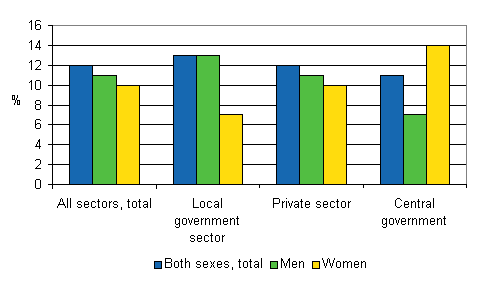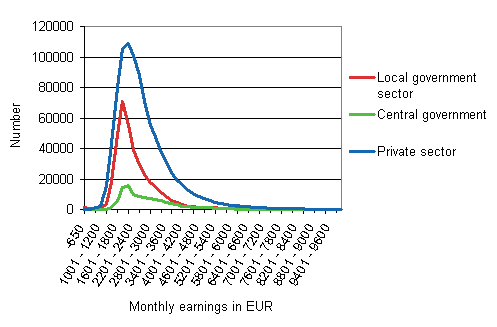Published: 16 November 2007
Only 35 per cent of local government sector wage and salary earners reach the sector's average level of earnings
According to Statistics Finland's Structure of Earnings statistics, the average monthly earnings of all full-time wage and salary earners were EUR 2,634 in the last quarter of 2006 and the median earnings1 were EUR 2,344. The difference between average monthly earnings and median earnings was greatest for wage and salary earners in the local government sector, at 13 per cent. In the private sector the difference was 12 per cent and in the central government sector 11 per cent. Women's average earnings were 80.2 per cent of men's average earnings in 2006. Measured with median earnings, the gender wage differential was 80.9 per cent. The different relationships between average and median earnings are caused by the different wage and salary earner structures in different sectors.
In 2006, ten per cent of all full-time wage and salary earners earned more than EUR 3,880 and, correspondingly, ten per cent of them earned less than EUR 1,693. The difference in earnings between the top and bottom deciles grew by 3 percentage points from 2005. The difference in earnings between deciles grew most, by 5 percentage points, in the private sector. The differences in earnings of wage and salary earners in the central government sector grew by 3 percentage points from the year before, while in the local government sector the difference in earnings between deciles remained nearly unchanged. Most of the differences in the development in earnings are explained by different sizes of collectively bargained pay increases, the stage of the economic cycle as well as changes in the structure of wage and salary earners.
The data derive from Statistics Finland's Structure of Earnings statistics, which cover all employer sectors. Monthly earnings for total hours worked are only calculated for full-time wage and salary earners. Besides earnings for regular working hours, total earnings also include pay for any possible overtime and working hour supplements but not one-off performance-based bonuses.
Difference between average monthly earnings and median earnings in different employer sectors by sex in 2006

The distribution of full-time wage and salary earners by monthly earnings in different employer sectors in 2006

1 Fifty per cent of the wage and salary earners earn more, and fifty per cent earn less, than the median earnings.
Source: Structure of Earnings 2006. Statistics Finland
Inquiries: Mr Antti Katainen +358 9 1734 2347, Ms Kaisa Salli +358 9 1734 2580, palkkarakenne.tilastokeskus@tilastokeskus.fi
Director in charge: Mr Kari Molnar
- Tables
-
Tables in databases
Pick the data you need into tables, view the data as graphs, or download the data for your use.
Last updated 16.11.2007
Official Statistics of Finland (OSF):
Structure of Earnings [e-publication].
ISSN=1799-0092. 2006. Helsinki: Statistics Finland [referred: 21.12.2025].
Access method: http://stat.fi/til/pra/2006/pra_2006_2007-11-16_tie_001_en.html

